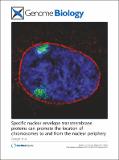Files in this item
Specific nuclear envelope transmembrane proteins can promote the location of chromosomes to and from the nuclear periphery
Item metadata
| dc.contributor.author | Zuleger, Nikolaj | |
| dc.contributor.author | Boyle, Shelagh | |
| dc.contributor.author | Kelly, David A | |
| dc.contributor.author | de Las Heras, Jose I | |
| dc.contributor.author | Lazou, Vassiliki | |
| dc.contributor.author | Korfali, Nadia | |
| dc.contributor.author | Batrakou, Dzmitry G | |
| dc.contributor.author | Randles, K Natalie | |
| dc.contributor.author | Morris, Glenn E | |
| dc.contributor.author | Harrison, David J | |
| dc.contributor.author | Bickmore, Wendy A | |
| dc.contributor.author | Schirmer, Eric C | |
| dc.date.accessioned | 2015-03-13T15:31:08Z | |
| dc.date.available | 2015-03-13T15:31:08Z | |
| dc.date.issued | 2013-02-15 | |
| dc.identifier | 173393287 | |
| dc.identifier | 010c3c2b-853d-42c2-af54-5270d3323e85 | |
| dc.identifier | 84873721028 | |
| dc.identifier.citation | Zuleger , N , Boyle , S , Kelly , D A , de Las Heras , J I , Lazou , V , Korfali , N , Batrakou , D G , Randles , K N , Morris , G E , Harrison , D J , Bickmore , W A & Schirmer , E C 2013 , ' Specific nuclear envelope transmembrane proteins can promote the location of chromosomes to and from the nuclear periphery ' , Genome Biology , vol. 14 , no. 2 , R14 . https://doi.org/10.1186/gb-2013-14-2-r14 | en |
| dc.identifier.issn | 1465-6906 | |
| dc.identifier.other | RIS: urn:ABBD38898420DB59F8568E427B153EF4 | |
| dc.identifier.other | ORCID: /0000-0001-9041-9988/work/64034203 | |
| dc.identifier.uri | https://hdl.handle.net/10023/6228 | |
| dc.description.abstract | BACKGROUND: Different cell types have distinctive patterns of chromosome positioning in the nucleus. Although ectopic affinity-tethering of specific loci can be used to relocate chromosomes to the nuclear periphery, endogenous nuclear envelope proteins that control such a mechanism in mammalian cells have yet to be widely identified. RESULTS: To search for such proteins twenty three nuclear envelope transmembrane proteins were screened for their ability to promote peripheral localization of human chromosomes in HT1080 fibroblasts. Five of these proteins had strong effects on chromosome 5, but individual proteins affected different subsets of chromosomes. The repositioning effects were reversible and the proteins with effects all exhibited highly tissue-restricted patterns of expression. Depletion of two nuclear envelope transmembrane proteins that were preferentially expressed in liver each reduced the normal peripheral positioning of chromosome 5 in liver cells. CONCLUSIONS: The discovery of nuclear envelope transmembrane proteins that can modulate chromosome position and have restricted patterns of expression may enable dissection of the functional relevance of tissue-specific patterns of radial chromosome positioning. | |
| dc.format.extent | 20 | |
| dc.format.extent | 9948750 | |
| dc.language.iso | eng | |
| dc.relation.ispartof | Genome Biology | en |
| dc.subject | Genetics | en |
| dc.title | Specific nuclear envelope transmembrane proteins can promote the location of chromosomes to and from the nuclear periphery | en |
| dc.type | Journal article | en |
| dc.contributor.institution | University of St Andrews. School of Medicine | en |
| dc.identifier.doi | https://doi.org/10.1186/gb-2013-14-2-r14 | |
| dc.description.status | Peer reviewed | en |
This item appears in the following Collection(s)
Items in the St Andrews Research Repository are protected by copyright, with all rights reserved, unless otherwise indicated.

